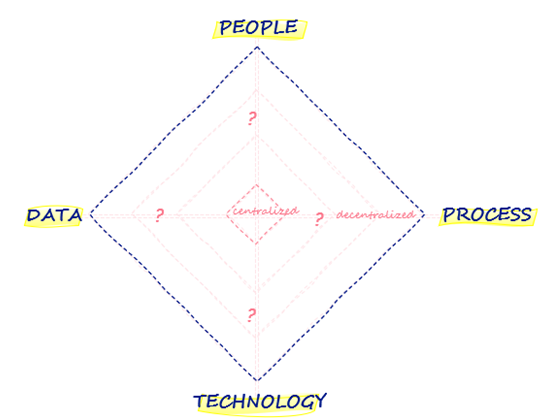How Decentralized are your Data Products?
In today's fast-paced and data-driven world, organizations face the challenge of managing and utilizing vast amounts of data efficiently. As a leading data and analytics consulting firm, Plainsight understands the importance of optimizing data products to foster innovation, enhance decision-making, and maintain a competitive edge. One crucial aspect of this optimization is the level of decentralization in data products.
The diagram above provides a visual framework for assessing the decentralization of your data products across four key dimensions: People, Process, Technology, and Data. Each axis represents a spectrum from centralized to decentralized, offering insights into how your organization manages these crucial components. Let's delve into each dimension and explore why decentralization can be beneficial.
People
The People axis evaluates the distribution of expertise and decision-making authority within your organization. In a highly centralized setup, decisions and data-related tasks are handled by a core group of specialists. While this can ensure consistency and control, it may also lead to bottlenecks and slower response times. Conversely, decentralizing responsibilities empowers teams across the organization, fostering agility and innovation. It allows for quicker decision-making and enhances the ability to respond to changing market demands.
Process
Processes define how data is collected, processed, and utilized within the organization. Centralized processes might involve rigid workflows and standardized procedures, which can be effective for maintaining quality and compliance. However, they can also stifle creativity and slow down the implementation of new ideas. Decentralizing processes encourages flexibility and experimentation, enabling teams to tailor workflows to their specific needs and quickly adapt to new opportunities or challenges.
Technology
The Technology axis assesses the distribution and integration of technological tools and platforms. Centralized technology frameworks offer the advantage of uniformity and simplified maintenance, but they may lack the adaptability required in a rapidly evolving technological landscape. Decentralized technology architectures, on the other hand, promote the use of diverse tools and solutions that can be customized to meet the unique requirements of different departments or projects. This approach can lead to increased innovation and better alignment with specific business goals.
Data
Data itself can be centralized or decentralized, impacting how it is accessed, shared, and utilized. Centralized data repositories ensure consistency and security, making it easier to manage and govern data. However, they can also create access bottlenecks and limit the ability to derive insights in real-time. Decentralizing data allows for more seamless and immediate access, empowering teams to leverage data more effectively and drive data-driven decision-making across the organization.
Finding the right balance
While decentralization offers numerous benefits, it is essential to find the right balance that aligns with your organization's goals and capabilities. Too much decentralization can lead to fragmentation and inconsistencies, while too much centralization can hinder agility and innovation. Assessing your current state using the provided framework can help identify areas where decentralization can be introduced or enhanced.
Wrap up
Decentralization is not a one-size-fits-all solution, but a strategic approach to enhancing the effectiveness and responsiveness of your data products. By evaluating and adjusting the levels of decentralization across People, Process, Technology, and Data, your organization can achieve a more agile, innovative, and data-driven environment.
At Plainsight, we specialize in guiding organizations through this assessment process and implementing tailored strategies to optimize the decentralization of data products. Our expertise in data and analytics ensures that your organization can harness the full potential of its data assets while maintaining control and consistency.
Ready to explore how decentralized your data products are? Contact Plainsight today, and let our experts help you navigate this transformative journey.


